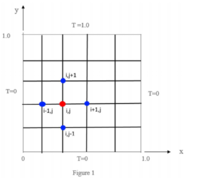maggiegold
New member
- Joined
- Jan 23, 2021
- Messages
- 5
I am given this question- I'm stuck with using programming to solve discretion problems
Question 1a) Express Tij @ t+1 = F(Ti+1,j, Ti-1,j, Ti,j+1, Ti,j-1) at t explicitly, then advance in time
Question 1b)
Suppose, there is no t variable, now what? Make a guess!
Ideally: F(Ti,j, Ti+1,j , Ti-1,j, Ti,j+1, Ti,j-1)=0
With guessed values: F(Ti,j, Ti+1,j , Ti-1,j, Ti,j+1, Ti,j-1)= err(/=0)
Objective is to reduce error as much as possible
Requirements
Write down discretized equations(interior, boundary)- explicit, implicit?
Specify what algorithms are used and how to program?

This problem is continued at:
Question 1a) Express Tij @ t+1 = F(Ti+1,j, Ti-1,j, Ti,j+1, Ti,j-1) at t explicitly, then advance in time
Question 1b)
Suppose, there is no t variable, now what? Make a guess!
Ideally: F(Ti,j, Ti+1,j , Ti-1,j, Ti,j+1, Ti,j-1)=0
With guessed values: F(Ti,j, Ti+1,j , Ti-1,j, Ti,j+1, Ti,j-1)= err(/=0)
Objective is to reduce error as much as possible
Requirements
Write down discretized equations(interior, boundary)- explicit, implicit?
Specify what algorithms are used and how to program?

This problem is continued at:
I ask this question before. Now giving the updates on the question about discretization problem
Older post reference: https://www.freemathhelp.com/forum/threads/question-on-numerical-methods-how-do-i-use-programming-to-solve-discretion-problems.127729/#post-524836 I am given this question- I'm stuck with using programming to solve discretion problems For Question 1a), I am given that...
www.freemathhelp.com
